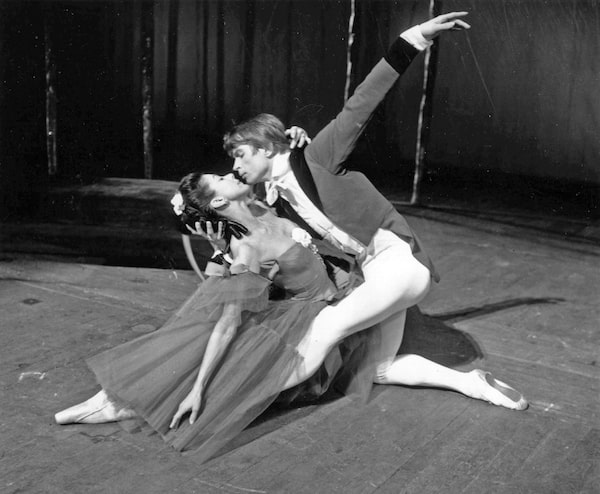
Soviet-born ballet dancer Rudolf Nureyev performs with Ghislaine Thesmar during a scene from the ballet Afternoon of a Faun.DOMINIQUE FAGET/AFP/Getty Images
- Nureyev
- Directed by: Jacqui and David Morris
- Classification: NA; 109 mins
In 1961, two months after the Soviets sent Yuri Gagarin into space, Rudolf Nureyev brought the USSR’s reputation crashing back to earth when he defected in Paris. In Nureyev, a new documentary by siblings Jacqui and David Morris, we see this swift juxtaposition of events, with the East gaining unprecedented ground in Cold War optics only to be summarily humiliated. Ballet was high politics in the Soviet Union, a symbol of nationalism and a vehicle for propaganda. The widely publicized escape of its greatest male dancer was hard for the Soviets to spin.
Nureyev was born on a Trans-Siberian train in 1938 and, after defecting at the age of 23, didn’t return to the Soviet Union until Mikhail Gorbachev and perestroika made that possible in the 1980s. This great luminary of 20th-century ballet, among the finest male dancers of all time, seems to be having a moment; a second film, The White Crow, directed by Ralph Fiennes and written by David Hare, will be released in May. Perhaps the interest has been inspired by the renewed chill along the erstwhile Iron Curtain. Whether they be classical dancers or postpunk feminist rock bands, artists pose a particular threat in suppressed societies. (Although today, ironically, the most famous defector has swum against the Atlantic’s current; he’s neither an artist nor a Russian, but an American whistle-blower under protection in Moscow.)
The new documentary is satisfying in some regards and frustrating in others. There’s a lot of good footage of Nureyev dancing and even better recordings of him giving frank TV interviews in the seventies, wearing some pretty outrageous suits and knee-high boots. We get anecdotal descriptions of his onstage power – his much-noted creaturely presence and animalistic force – from various important ballerinas, critics and biographers. There are engaging excerpts from his memoirs, read by Welsh actress Sian Phillips, and interviews with old friends from his school days in Leningrad.
But the portrait the Morrises have painted feels rather uncritically reverential and safe. Nureyev had a reputation for his ego, his temper and his tantrums; the film points our attention to this without really substantiating it. A funny episode relays the young dancer posing for American photographer Richard Avedon in the south of France in the early sixties. We see the fruits of the shoot – pictures that exude sensuality and dynamism. Having seen the photos, Nureyev was confident that Avedon truly understood him. So, it’s comical to have this framed by the photographer’s own perspective: “His whole body was responding to a kind of wonder at himself. A narcissistic orgy of some kind. An orgy of one.”
But where else is this narcissism? Nureyev comes off as a kind and thoughtful artist who, despite his preternatural commitment to dancing, seems charming, funny and, dare I say, almost down to earth. When asked by TV interviewer if he’s game for talking about his personal life, Nureyev smiles wryly and, in his accented English, suggests that they go “50-50.” His compassion for others is evident throughout his life. The documentary’s best material might be its depiction of the two great loves of Nureyev’s life: his fiery romance with the Danish dancer Erik Bruhn, with whom he remained close with until Bruhn’s death in 1986, and his partnership with Margot Fonteyn.

Nureyev's partnership with Margot Fonteyn is explored with depth and insight in the Morrises' film.Keystone/Keystone/Getty Images
Fonteyn was 42 years old and on the brink of retirement when she started dancing with the 23-year-old Nureyev. It was the sort of partnership that made zero sense on paper but wrought magic on stage. The Morrises provide touching insight into their artistic admiration and personal fondness for each other, suggesting that their love had a physical dimension offstage – a hotly contested speculation in the ballet world. The film relays their heartbreak at seeing one another’s bodies deteriorate from illness; Fonteyn died of cancer in 1991 and Nureyev of AIDS-related illness in 1993. Footage of them performing the tomb scene from Kenneth Macmillan’s Romeo and Juliet is shown as Nureyev says in a voiceover: “To me she is a part of my family. That’s all that I have. Only her.”
It’s a shame the Morrises don’t include more of Nureyev’s performance footage and opt, instead, to use long segments of contemporary dance reconstructions choreographed by Russell Maliphant. The segments look a bit garish and out of place, not necessarily because of their poor choreographic content, but as they have little aesthetic or conceptual continuity with the rest of the film. Globe and Mail readers might also rue the lack of Canadian content; Nureyev spent 13 seasons at the National Ballet and made a fine partner to both Karen Kain and Veronica Tennant. He also nearly bankrupted the company in 1975 with his lavish production of The Sleeping Beauty. Allegedly, the chairman of the board saved the day by mortgaging his house.
Nureyev opens April 19 at Toronto’s Hot Docs Ted Rogers Cinema
Editor’s note: (April 30, 2019) An earlier version of this article said Nureyev spent several seasons at the National Ballet. It was 13.
 Martha Schabas
Martha Schabas